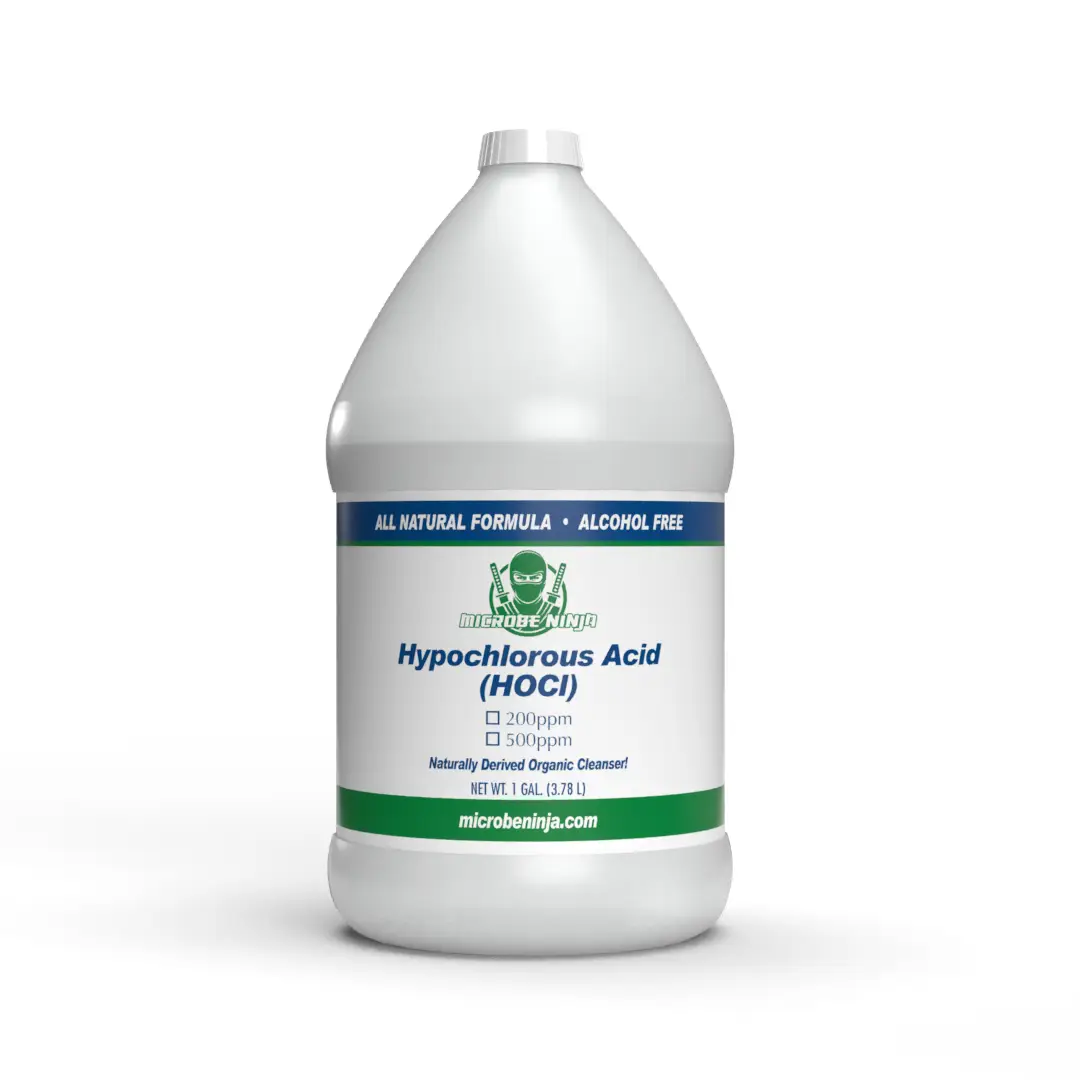Hypochlorous acid (HOCL) may be strong or weak, depending on the level of PPM of the free active chlorine (FAC). There are strengths as low as 2.5 PPM and as high as 800 up to 1000 PPM. Because these solutions are already 99% water, they are very simple to dilute.
It’s also important to understand that the FAC (free active chlorine) is present in hypochlorous acid for different uses (measured in parts per million or PPM).
Note: Microbe Ninja’s line of hypochlorous acid (HOCL) generators can produce pH-neutral HOCL as high as 1000 ppm, which allows you to dilute it with clean water to as low as necessary.
Here are some examples of both strong and weaker hypochlorous acid solution uses.
Eye care – Weak – 2.5 PPM HOCL solution is safe for long-term daily use.
Hypochlorous acid is commonly used in ophthalmology and can be found in common eye care products. Our eyes are delicate areas, so the combination of this gentle yet potent antimicrobial agent helps fight infection and reduce inflammation. Hypochlorous acid is used for the ongoing treatment of blepharitis and chronic dry eyes.
Blepharitis is caused by an overgrowth of bacteria around the eyelids. Hypochlorous Acid is a great natural antimicrobial agent, and it works by significantly reducing bacteria around the eyelids and eyelashes. HOCL reduces the bacterial load around our eyes by over 90%.
Wound care – Weak – 2.5 PPM HOCL solution is safe for long-term daily use
Did you know? Hypochlorous acid was used during both WWI and WW2 for wound cleaning and for neutralizing chemical burns. HOCL is an ideal wound care agent because of its efficacy in targeting the bacteria that causes the infection without harming healthy tissue.
Pet care – Weak – 2.5 PPM HOCL solution is safe for long-term daily use.
HOCL is used for small and large animals in wound care for its bacteria and viruses-killing properties. Common dermatological issues for animals, like Pruritis (chronic itching), can be caused by allergies, parasites, and infections. The scratching and licking that goes along with all that can cause red, inflamed areas that also lead to painful bacteria infections. Hypochlorous acid soothes your pet’s skin, reduces pain, and helps reduce factors that allow for bacteria growth.
Medical – Strong – 460 and above PPM HOCL
Hypochlorous acid, generated on-site, at a minimum level of HOCL 460 ppm, has been shown to be effective against pathogens including Clostridium difficile (C. diff) spores, tuberculosis, and MRSA.
Skin Care – Weak – 2.5 PPM HOCL solution is safe for long-term daily use.
Dermatologists are now harnessing the power of hypochlorous acid for the skin, fighting bacteria (the cause of acne), healing wounds faster, and combating inflammation that comes with conditions like eczema and psoriasis. During the pandemic, dermatologists turned to hypochlorous acid to help combat “mask-ne” – a result of wearing face masks.
Hypochlorous acid is great for sensitive skin, because it doesn’t dry out or irritate the skin. It is not a replacement for cleansing and scrubbing, but HOCL offers an extra line of defense for removing bacteria and healing skin.
Air and Surface Deodorization – Stronger – 200 PPM HOCL
A HOCL 200 ppm level works well for surface and air deodorization.
Hand Cleanser and Moisturizer – Strong – 100 to 200 PPM or 50 to 150 PPM HOCL
As a hand cleaner, hypochlorous acid with a level between 100 and 200 ppm works well and is not irritating to the skin. In fact, it is soothing to the skin and helps repair wounds.
When used as a moisturizer and cleanser, in most formulations for both pets and humans, the hypochlorous acid is in the range of 50 to 150 ppm.
Food Safety – Weak – 50 PPM HOCL solution is safe for daily use.
When used as a food and vegetable wash and life extender, and as used on organic food at the level of 50 ppm.
Oil and Gas Industry – Weaker – 2.5 PPM HOCL solution is safe for long-term daily use.
The lowest HOCL concentration used in this industry is 2.5 ppm. Oil and gas companies drilling and fracking for oil and gas use hypochlorous acid. During the fracking process, liquids and chemicals are pumped into the ground and removed with oil and gas, then separated above ground.
The liquid must then be put back into the ground. But it must be treated with a biocide (like HOCL) first. This prevents the sulfate-reducing bacteria (SRBs) found in the liquid from producing hydrogen sulfide gas. This bacteria is the number one cause of death for workers. The typical treatment of fracking water with HOCL is 2.5ppm FAC.
NinjaGen On-site hypochlorous acid generators
Businesses (i.e. medical offices, farms, schools, restaurants and more) can now take advantage of Microbe Ninja’s NinjaGen on-site hypochlorous acid generators. The NinjaGen Compact will produce a quality pH-neutral HOCL at pennies a gallon for smaller businesses and medical practices.
Learn more: https://microbeninja.com/ninjagen.
Note: Shelf life is another key differentiator. Once a bottle of a hypochlorous acid solution is opened, it becomes less stable and effective. Due to its naturally derived ingredients and lack of stabilizers, Hypochlorous Acid will expire after 30 days once opened. But it will maintain its effectiveness once bottled for 6 months.



Comments are closed